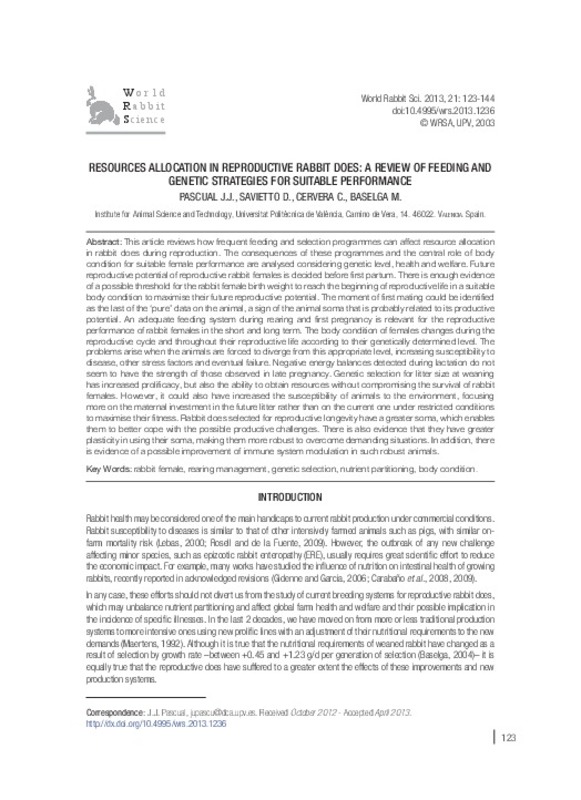JavaScript is disabled for your browser. Some features of this site may not work without it.
Buscar en RiuNet
Listar
Mi cuenta
Estadísticas
Ayuda RiuNet
Admin. UPV
Resources allocation in reproductive rabbit does: a review of feeding and genetic strategies for suitable performance
Mostrar el registro sencillo del ítem
Ficheros en el ítem
| dc.contributor.author | Pascual Amorós, Juan José
|
es_ES |
| dc.contributor.author | Savietto, Davi
|
es_ES |
| dc.contributor.author | Cervera Fras, Mª Concepción
|
es_ES |
| dc.contributor.author | Baselga Izquierdo, Manuel
|
es_ES |
| dc.date.accessioned | 2013-10-14T12:09:32Z | |
| dc.date.available | 2013-10-14T12:09:32Z | |
| dc.date.issued | 2013-10-01 | |
| dc.identifier.issn | 1257-5011 | |
| dc.identifier.uri | http://hdl.handle.net/10251/32794 | |
| dc.description.abstract | [EN] This article reviews how frequent feeding and selection programmes can affect resource allocation in rabbit does during reproduction. The consequences of these programmes and the central role of body condition for suitable female performance are analysed considering genetic level, health and welfare. Future reproductive potential of reproductive rabbit females is decided before first partum. There is enough evidence of a possible threshold for the rabbit female birth weight to reach the beginning of reproductive life in a suitable body condition to maximise their future reproductive potential. The moment of first mating could be identified as the last of the 'pure' data on the animal, a sign of the animal soma that is probably related to its productive potential. An adequate feeding system during rearing and first pregnancy is relevant for the reproductive performance of rabbit females in the short and long term. The body condition of females changes during the reproductive cycle and throughout their reproductive life according to their genetically determined level. The problems arise when the animals are forced to diverge from this appropriate level, increasing susceptibility to disease, other stress factors and eventual failure. Negative energy balances detected during lactation do not seem to have the strength of those observed in late pregnancy. Genetic selection for litter size at weaning has increased prolificacy, but also the ability to obtain resources without compromising the survival of rabbit females. However, it could also have increased the susceptibility of animals to the environment, focusing more on the maternal investment in the future litter rather than on the current one under restricted conditions to maximise their fitness. Rabbit does selected for reproductive longevity have a greater soma, which enables them to better cope with the possible productive challenges. There is also evidence that they have greater plasticity in using their soma, making them more robust to overcome demanding situations. In addition, there is evidence of a possible improvement of immune system modulation in such robust animals. | es_ES |
| dc.description.sponsorship | This work was carried out thanks to the research developed in the last decade with the support of different grants from the Spanish Ministry of Science and Innovation (AGL2000-0595-C03-03, AGL 2004-02710, AGL2008-00273 and AGL2011-30170-C02-01). | |
| dc.language | Inglés | es_ES |
| dc.publisher | Editorial Universitat Politècnica de València | |
| dc.relation.ispartof | World Rabbit Science | |
| dc.rights | Reserva de todos los derechos | es_ES |
| dc.subject | Rabbit female | es_ES |
| dc.subject | Rearing management | es_ES |
| dc.subject | Genetic selection | es_ES |
| dc.subject | Nutrient partitioning | es_ES |
| dc.subject | Body condition | es_ES |
| dc.title | Resources allocation in reproductive rabbit does: a review of feeding and genetic strategies for suitable performance | es_ES |
| dc.type | Artículo | es_ES |
| dc.date.updated | 2013-10-14T11:49:56Z | |
| dc.identifier.doi | 10.4995/wrs.2013.1236 | |
| dc.relation.projectID | info:eu-repo/grantAgreement/MICYT//AGL2000-0595-C03-03/ES/ADECUACION NUTRITIVA A LINEAS DE CONEJOS MEJORADAS GENETICAMENTE/ | es_ES |
| dc.relation.projectID | info:eu-repo/grantAgreement/MICYT//AGL2004-02710/ES/MEJORA GENETICA DEL CONEJO DE CARNE: REPRODUCCION Y LONGEVIDAD/ | |
| dc.relation.projectID | info:eu-repo/grantAgreement/MICINN//AGL2008-00273/ES/IDENTIFICACION DE FACTORES DE PATOGENICIDAD Y CARACTERIZACION INMUNOPATOLOGICA DE SU EFECTO EN MAMITIS CUNICOLAS PROVOCADAS POR STAPHYLOCOCCUS AUREUS./ | |
| dc.relation.projectID | info:eu-repo/grantAgreement/MICINN//AGL2011-30170-C02-02/ES/ESTUDIO DEL SISTEMA INMUNE DE DIFERENTES LINEAS GENETICAS CUNICOLAS Y SU RESPUESTA FRENTE A DESAFIOS PRODUCTIVOS E INFECCIOSOS/ | |
| dc.rights.accessRights | Abierto | es_ES |
| dc.contributor.affiliation | Universitat Politècnica de València. Instituto de Ciencia y Tecnología Animal - Institut de Ciència i Tecnologia Animal | es_ES |
| dc.contributor.affiliation | Universitat Politècnica de València. Departamento de Ciencia Animal - Departament de Ciència Animal | es_ES |
| dc.contributor.affiliation | Universitat Politècnica de València. Escuela Técnica Superior de Ingeniería Agronómica y del Medio Natural - Escola Tècnica Superior d'Enginyeria Agronòmica i del Medi Natural | es_ES |
| dc.description.bibliographicCitation | Pascual Amorós, JJ.; Savietto, D.; Cervera Fras, MC.; Baselga Izquierdo, M. (2013). Resources allocation in reproductive rabbit does: a review of feeding and genetic strategies for suitable performance. World Rabbit Science. 21(3):123-144. https://doi.org/10.4995/wrs.2013.1236 | es_ES |
| dc.description.accrualMethod | SWORD | es_ES |
| dc.relation.publisherversion | https://doi.org/10.4995/wrs.2013.1236 | es_ES |
| dc.description.upvformatpinicio | 123 | es_ES |
| dc.description.upvformatpfin | 144 | es_ES |
| dc.description.volume | 21 | |
| dc.description.issue | 3 | |
| dc.identifier.eissn | 1989-8886 | |
| dc.contributor.funder | Ministerio de Ciencia e Innovación | |
| dc.contributor.funder | Ministerio de Ciencia y Tecnología | es_ES |








